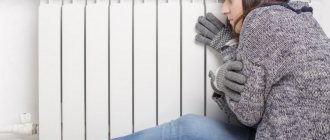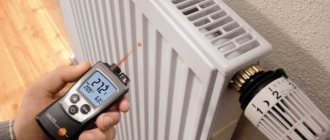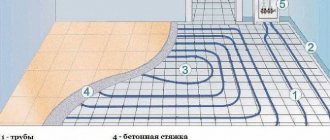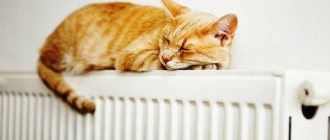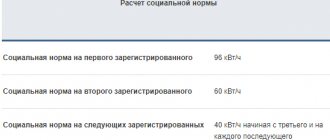Normative base
Heat standards are determined taking into account the purpose of a particular room:
- For bedrooms and other living rooms, the best temperature is considered to be 17-19 degrees. These indicators are the most comfortable for a person.
- In the kitchen, in addition to the heating system, there are a number of devices that heat the air. Therefore, the maximum temperature here should not exceed 18 degrees.
- It is believed that for children and women the norms should be increased by 2-3 degrees.
On average, the temperature range in an apartment should be 18-25 degrees, and in corner apartments - up to 28 degrees.
General provisions and scope
1.1. Sanitary rules and regulations (hereinafter referred to as sanitary rules) have been developed in accordance with the legislation of the Russian Federation. 1.2. These sanitary rules establish mandatory sanitary and epidemiological requirements for living conditions in residential buildings and premises, which must be observed when placing, designing, reconstructing, constructing and operating residential buildings and premises intended for permanent residence. 1.3. The requirements of these sanitary rules do not apply to living conditions in buildings and premises of hotels, hostels, specialized homes for the disabled, orphanages, and rotational camps. 1.4 The sanitary rules are intended for citizens, individual entrepreneurs and legal entities whose activities are related to the design, construction, reconstruction and operation of residential buildings and premises, as well as for bodies authorized to carry out state sanitary and epidemiological supervision. 1.5. Monitoring of compliance with the requirements of these sanitary rules is carried out by bodies authorized to carry out state sanitary and epidemiological supervision in accordance with the legislation of the Russian Federation.
Temperature in the apartment during the heating season according to SanPin in 2019-2020
All standards are approved by the legislature and are based on GOST R 51617-2000 Housing and communal services.
A specific list of standards in this document sets the lower temperature limit:
- For living rooms - 18 degrees.
- Rooms with high humidity – 20 degrees.
- Basement and attic - 4 degrees.
- Corridor and stairs - 14 degrees.
- Storerooms - 12 degrees.
Particular attention is paid to the bathroom. The average temperature here should be about 25 degrees, that is, significantly higher than in other rooms of the apartment. An interval from 18 to 26 degrees is allowed, taking into account the air flow of at least 0.2 m/s.
Applications to SanPiN 2.1.2.2645-10
Lighting standards for adjacent areas
| Illuminated areas of territories | Average horizontal illumination at ground level, lux |
| Transitional alleys and roads, bicycle paths | 4 |
| Internal service and firefighting passages, sidewalks and entrances | 2 |
| Parking lots, utility areas and waste disposal areas | 2 |
| Walking paths | 1 |
| Physical education grounds and playgrounds for children | 10 |
Are interruptions in the heat supply acceptable?
In addition to the question of what temperature should be in the apartment, it is important to know about the permissible periods for turning off the heating.
Decree of the Government of the Russian Federation No. 354 of 2011 stipulates that heat must be supplied around the clock and without interruption. However, in a number of situations, turning off the heating is allowed. But the total shutdown period within a month should not exceed 24 hours.
You also need to take into account the air temperature in residential premises at the time the heating is turned off:
- If it is not higher than 12 degrees, you can turn it off for no more than 16 hours.
- At a temperature of 10-12 degrees - for 8 hours.
- And within 8-10 degrees - no more than 4 hours.
If utility services fail to solve the problem within the allotted time, then for each hour exceeded, a payment reduction of 0.15% is provided.
Useful video
Details about degrees:
Dear readers! To solve your problem right now, get a free consultation
— contact the lawyer on duty in the online chat on the right or call: +7 (499) 938 6124 — Moscow and region.
+7 (812) 425 6761 — St. Petersburg and region. 8 (800) 350 8362 - Other regions of the Russian Federation You will not need to waste your time and nerves - an experienced lawyer will solve all your problems! Or describe the situation in the form below:
Temperature indicators
As stated above, GOST determines the minimum and maximum heat levels in apartments.
What could be the minimum
For residential premises, the minimum is 18 degrees (20 in corner apartments). For residents of regions with cold climates there is an additional norm. If there is severe frost outside (temperature below 30 degrees for five days), then the minimum norm in the apartment is +20 (22 for corner apartments).
From midnight to five in the morning it is allowed to reduce the water temperature in radiators by 3 degrees. But you can’t do this during the day.
For non-residential premises, special standards have been developed - from 4 degrees in the attic to 25 degrees in the bathroom. It should not be colder than +10 in the elevator, and +16 on the stairs.
Is there a maximum set?
In addition to the minimum standard, GOST also defines a maximum. It cannot be higher than the minimum by more than 4 degrees. That is, the existing norm for residential premises is no more than 21 degrees (23 degrees in corner rooms).
Heating time
The heating period depends on the external environment and the weather outside. The decision on heating is made by the local government, usually the municipality. This happens if the average daily outside temperature drops below 7 degrees.
In most modern houses there is another system - automatic. The temperature at the outlet of the boiler and the decision to supply hot water to the heating system are made by automation, which monitors outdoor indicators.
At the same time, the temperature of the coolant is regulated, which is convenient. This prevents residents from languishing from excessive heat at the beginning and end of the heating season.
Possible sanctions
If the temperature standards described above in the apartment are not met due to the fault of the management company, then for each hour when the heating level did not meet the standards, the payer should receive a discount of 0.15% of the payment amount. The entire discount amount cannot exceed the payment amount, but may be equal to it. That is, if the coolant in the radiators was cold, then the payer has the right to be exempt from payment for this period.
How to attract a service organization?
By law, utility services must inform payers about upcoming repairs and other reasons for heating outages. That is, they must indicate during what period the heating will be turned off.
Filing an application
In the event that residents discover that the radiators in their apartment are not heating, they must report this to the emergency service of the organization servicing the heating system of this house.
The application can be submitted in writing or orally, but be sure to provide your contact information.
The employee who accepts the application must register it and the time of its receipt. The size of the discount when recalculating the cost of home heating services depends on this.
Verification and examination
Within two hours after registering the application (unless the applicant himself has indicated a different time), specialists must arrive at the apartment with an inspection.
Based on the results of the inspection, they draw up a report that all interested parties must sign. If someone does not agree with the inspection data and does not sign the report, this will be considered grounds for conducting an additional examination.
The contractor pays for the examination, but if its results prove that the temperature in the apartment complies with the standards, then the consumer will be obliged to reimburse the costs of carrying out this check.
If the wall freezes
SanPin states that the difference between the air temperature inside the apartment and the temperature on the outside of the wall should not be more than 4 degrees. That is, at a temperature inside of 18 degrees, the wall should be no colder than 14.
Otherwise, this indicates the need to check and repair the seams, as well as insulate the wall. All this is the responsibility of the management company, so you need to write a complaint to its administration.
The management company must send specialists to check and draw up the appropriate act. If the Criminal Code does not solve the problem, then you need to file a complaint about its inaction with the State Housing Inspectorate, Rospotrebnadzor, the prosecutor's office or the court. You can contact the prosecutor's office and the court only if complaints to the two previous organizations also did not produce results.
Problems with the heating system
Such problems, as they say, lie on the surface. Their consequence is not only barely warm radiators, but also increased humidity due to freezing and thawing of the walls. This inevitably leads to the formation of fungus. Of course, such conditions are far from normal for living. Typical signs of heating problems:
- small leak in the radiator,
- noise and bubbling in pipes,
- difference in radiator temperature within one apartment,
- heat distribution is uneven across the floors of the house,
- problems in the apartment building system as a whole.
When preparing apartment buildings for the heating season, the management company is obliged to check all systems. If any of them fails, then a number of actions must be taken to eliminate it.
Responsibility of housing and communal services and the management company for violation of temperature conditions
There are situations when the management company or housing and communal services organization does not have its own emergency service and does not comply with the heating shutdown deadlines. In this case, you can check the compliance of the air temperature in the apartment with the standards yourself and independently draw up an act, which must be signed by at least two consumers of utility services and the chairman of the building council. In this case, the document will have legal force and from the moment it is signed, you can count the time for the provision of poor-quality services, and therefore demand compensation for this.
If utility workers quickly respond to a complaint, there will be no consequences for them. Otherwise, residents will file a complaint with the state inspection authorities. As a result, utilities will be held accountable and fined for an administrative violation.
But if victims have evidence that the decrease in temperature in the house led to health problems, then they will be able to recover damages in civil court.
If serious consequences occur, a criminal case may even be initiated.
It should be
After turning on the heating, some time must pass (up to five days) for the system to operate at full capacity. If hydraulic parameters (pressure) are not observed, overload and failure will occur. Therefore, if your house has already begun to be heated, but your radiators continue to remain cold, do not rush to worry and complain, some time must pass. The reasons for cold radiators in an apartment can be different.
If more than five days have passed, or the heating has been turned on in the whole house, but not in your apartment, then some kind of failure has occurred. In this case, it is already necessary to involve utility services. If it is very hot in the apartment during the heating season, this is also a reason to contact a specialist.
